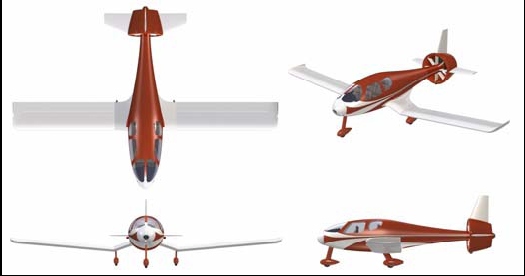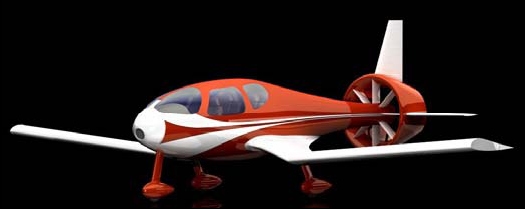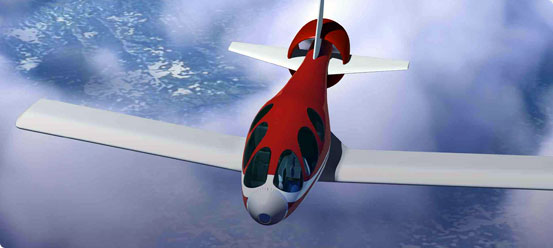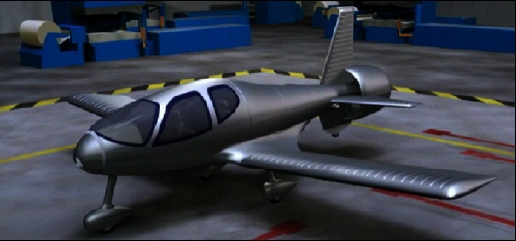A “Personal Air Vehicle” (PAV) from NASA_Langley, circa 2003-2005. Yet another in a long line of designs that would, it was hoped, bring Flight To The Masses. Regardless of the technology of the aircraft, though, there will always be one major impediment to Flight For The Masses within the United States… the FAA. As anyone with even a slight medical issues (such as me with my asymptomatic Type 2 Diabetes) can usually attest, the FAA is not exactly interested in the filling the sky with pilots.
This particular PAV concept used a mid-mounted engine with a long drive shaft to power an aft fan. The idea was to create a vehicle with certain capabilities, acronymed EQuiPT (Easy-to-use, Quiet, Personal Transportation). An automotive engine coupled with a shrouded fan would, hopefully, produce a relatively simple and easy to maintain design with minimum noise.
• Length: 8.08 m (26.5 ft)
• Height: 3.29 m (10.8 ft)
• Wing Span: 11.89 m (39.0 ft)
• Wing Area: 15.10 m^2 (162.5 ft^2)
• Cabin Length: 2.53 m (8.3 ft)
• Cabin Width: 1.40 m (4.6 ft)
• Cabin Height: 1.22 m (4.0 ft)
• Cabin Volume: 3.91 m^3 (138.0 ft^3)
• Gross Weight: 1633 kg (3600 lb)
• Empty Weight: 1111 kg (2450 lb)
• Useful Load: 522 kg (1150 lb)
• Fuel Capacity: 322 l (85 gal)
• Engine: Chevrolet LS-1 V8
• Power: 224 kW (300 hp)
• Cruise Speed: 302 km/hr (163 kts)
• Cruise efficiency: 5.4 km/l (11.1 nm/gal)
• Cruise Fuel Flow: 55.3 l/hr (14.6 gal/hr)
• Landing Speed: 96 km/hr (52 kts)
• Landing Gear: Fixed Tricycle
NASA continues to study the PAV idea.
And yes, the pics are small and crappy.
Read nothing more about PAVs in the latest Issue of Aerospace Projects Review!
One Response to “NASA “Civetta””
Sorry, the comment form is closed at this time.




The only bid i ever lost with NASA was on their RFP for six different vehicles in the Vehicles System Program , or VSP. It included a supersonic bizjet, a BWB, a forward swept wing passenger jet with the engines on top of the wings, a very large tiltrotor, the PAV and a modified version of Helios.
They supplied three view, and perspective CAD renderings with some interesting paint schemes (basically a starfield over the top of the vehicles)
I took the 3-views in rhino and banged out some quick CAD models that RPS used to generate some quotes. At the time I was working there and they were interested in doing the models. But in the end we came in secong on the bids, the winning company was a group of engineers in Pismo Beach. They bid it too low and I think they are out of business.
The problem with lots of small easy to fly personal airplanes is that you’d need airstrips everywhere and no power lines, and vehicles like mollers air car, which is now a little flying saucer is noise.
When I was in college I rented a room a house that was right next to the 405 freeway. The landlord told me “you’ll get used to it”(the rumbling, crashing, roaring sound of big rigs behind the sound wall) Well i never did, and I spent all my time at my girlfriend eventually wife’s house.
Can you imagine the noise of one Moller air car with 8 rotary engines running at full power? how about ten?
There’s a neat looking two seat three wheeled vehicle called the Aptera, it’already very swoopy and if you stuck contra-rotating helo blades that folded up when not used, you could be stuck in traffic, unfold the blades, the take off straight up. It could use existing GPS and street maps to follow traffic routes and a simple transponder could keep you aware of other vehicles. If you’ve ever seen the robotic helo UAV’s they fly perfect. Put in a ballistic ‘chute recovery system and I think you’d have a viable PAV.